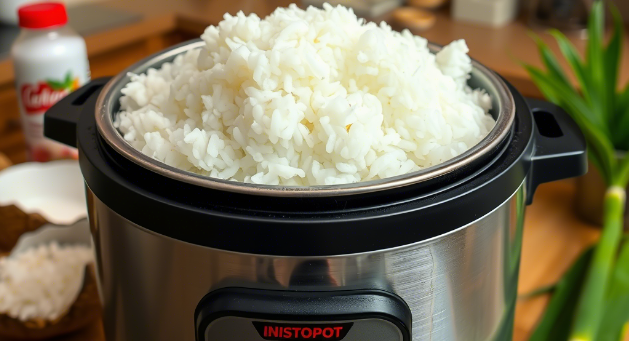Coconut Rice in Rice Cooker — Fragrant, Fluffy, Foolproof

Every cook should have a few simple but impressive side dishes in their back pocket. For me, coconut rice is one of those. It’s fragrant, creamy, lightly sweet, and turns even the simplest meal into something memorable.
Making it in a rice cooker? Even better. Effortless, consistent, and hands-off. I’ve cooked coconut rice in professional kitchens, but honestly, it’s one of those things that comes out just as good at home with the push of a button.
Why Coconut Rice Works So Well in a Rice Cooker
Rice cookers are built to create the perfect cooking environment: steady heat, sealed-in moisture, and automatic shut-off when done. Coconut rice, with its richer liquid base, benefits hugely from this control.
Benefits of Making Coconut Rice in a Rice Cooker
- Perfectly cooked rice every time
- No burning or sticking
- Frees up stove space
- Locks in coconut aroma
- Stays warm for hours
Best Rice Types for Coconut Rice
| Rice Type | Result | Notes |
|---|---|---|
| Jasmine Rice | Soft, fragrant, fluffy | My personal favorite choice |
| Basmati Rice | Light, long-grain, separates | Less sticky, more delicate |
| Short Grain Rice | Sticky, creamy | Works well for a thicker texture |
Ingredients for Rice Cooker Coconut Rice

Coconut Jasmine Rice Ingredients
| Ingredient | Amount | Notes |
|---|---|---|
| Jasmine Rice | 2 cups (uncooked) | Rinsed until water runs clear |
| Coconut Milk | 1 can (13.5 oz) | Full-fat for best flavor |
| Water | 1 cup | Adjust slightly if needed |
| Salt | ½ teaspoon | Balances the sweetness |
| Sugar (Optional) | 1 teaspoon | For a subtle sweetness |
| Pandan Leaf (Optional) | 1 tied leaf | Traditional for extra aroma |
Instructions for Making Coconut Rice in Rice Cooker
Step 1 — Rinse the Rice
Always rinse your rice. It removes excess starch and prevents the rice from turning gummy.
Step 2 — Combine Ingredients
Add rinsed rice, coconut milk, water, salt, and sugar directly to the rice cooker pot. Stir well to combine.
Step 3 — Cook
Set the rice cooker to the standard white rice setting. Close the lid and let it do its thing.
Step 4 — Rest
Once the rice cooker switches to “warm”, let the rice sit undisturbed for 10 minutes. This helps the texture finish properly.
Step 5 — Fluff and Serve
Use a fork or rice paddle to gently fluff the rice before serving.
Alternative Cooking Methods for Coconut Rice
While rice cooker is king for convenience, here are other ways I’ve done it:
Stovetop
Simmer gently in a covered pot for 15-18 minutes. Rest before fluffing.
Instant Pot
Use rice or manual setting. Usually takes around 3-4 minutes high pressure with natural release.
Storage and Reheating
| Storage Method | Duration | Notes |
|---|---|---|
| Refrigerator | 3-4 days | Store in airtight container |
| Freezer | Up to 2 months | Portion into freezer-safe bags |
Reheating Tip
Add a splash of water or coconut milk when reheating in the microwave to restore moisture.
Common Mistakes to Avoid
After making coconut rice dozens of times in my rice cooker, I’ve learned a few hard lessons that I always keep in mind now. Let me share them with you to save you the trouble.
One mistake I made early on was using too much coconut milk. It’s tempting to think that more coconut flavor is better, but trust me, it can backfire. When I overloaded the rice with coconut milk, it turned greasy and overly soft, almost like a pudding. Now I always balance coconut milk with water — usually a 50/50 mix — and the rice comes out rich but still fluffy.
Another mistake I’ll never repeat is skipping the rinse. The first few times I made coconut rice, I didn’t bother rinsing the jasmine rice, thinking it wouldn’t matter much. Big mistake. The result was sticky, clumpy rice that lacked the lightness I was aiming for. Now I rinse the rice under cold water until it runs clear, and the difference is night and day.
Finally, I used to be so impatient that I would scoop the rice immediately after cooking, eager to dive in. But rushing it ruined the texture. Letting the rice rest for 10 minutes with the lid closed is absolutely essential. During this resting time, the moisture redistributes evenly, and the rice finishes steaming gently. Every time I do this now, the grains separate beautifully, and the coconut aroma fills the kitchen.
If you keep these simple lessons in mind, your coconut rice will come out perfect every time — fragrant, fluffy, and irresistibly delicious.
Serving Ideas
One of the things I love most about coconut rice is how incredibly versatile it is. After mastering the recipe, I started pairing it with all sorts of dishes, and it never disappoints.
My favorite way to serve it is alongside a rich, spicy Thai curry — red, green, or massaman. The creamy, slightly sweet rice balances the heat of the curry perfectly. I also love it with grilled chicken or shrimp, especially when marinated in tropical spices.
When I’m craving something a little more hearty, I pair coconut rice with a spicy beef stir-fry. The contrast between the bold beef flavors and the mellow coconut notes is just incredible.
For a fresher, summery option, mango or pineapple salsa on top of coconut rice is pure magic. It’s sweet, tangy, and refreshing. On seafood nights, I often serve it with teriyaki salmon — the umami from the teriyaki glaze complements the coconut rice so well.
And if you love skewers like I do, try coconut rice with peanut satay skewers. The nutty satay sauce and fragrant rice are a match made in heaven.
No matter how you serve it, coconut rice elevates any meal. It’s simple yet special — a side dish that quietly steals the show.
FAQ – Coconut Rice in Rice Cooker
Do I need to rinse the rice before cooking?
Yes, rinsing jasmine rice is important to remove excess starch, which helps achieve light, fluffy coconut rice without clumping.
Can I use light coconut milk instead of full-fat?
You can, but full-fat coconut milk gives a richer flavor and creamier texture. Light coconut milk will result in a slightly less fragrant and less creamy rice.
How do I prevent the rice from becoming mushy?
Use the correct ratio of liquid to rice, and rinse the rice thoroughly. Typically, for coconut rice, a 1:1 ratio of liquid (coconut milk and water combined) to rice works best.
Can I make coconut rice ahead of time?
Yes, coconut rice can be made ahead and stored in the refrigerator for up to three days. Reheat gently with a splash of water to restore moisture.
What type of rice is best for coconut rice?
Jasmine rice is the best choice because of its light floral aroma and soft texture. However, basmati or long-grain white rice can also work in a pinch.
How do I add extra flavor to coconut rice?
Adding a pandan leaf, a pinch of sugar, or toasted coconut flakes can enhance the flavor and aroma of the finished dish.
Can I cook coconut rice without a rice cooker?
Yes, coconut rice can be cooked on the stovetop. Bring the mixture to a boil, then reduce the heat, cover, and simmer gently until the liquid is absorbed.
Why is my coconut rice browning at the bottom?
This can happen if there is too little liquid or if your rice cooker runs hot. Adding a tiny bit more water or stirring once during cooking can help prevent browning.
Should I stir the rice during cooking?
No, avoid stirring during cooking. Let the rice steam undisturbed to maintain its fluffy texture. Stirring too early can make it sticky.
What dishes pair well with coconut rice?
Coconut rice pairs beautifully with curries, grilled seafood, spicy chicken, or tropical dishes like mango chicken or pineapple shrimp stir-fry.